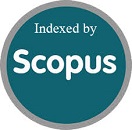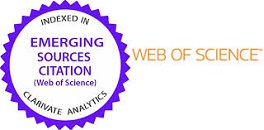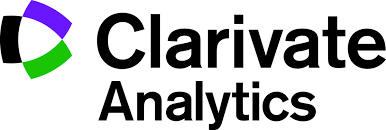Ductile and metallic nature of Co2VZ (Z= Pb, Si, Sn) Heusler compounds: A First Principles Study
Abstract
Herein, optoelectronic, elastic and magnetic properties of L21 structured Co2VZ (Z= Pb, Si, Sn) full Heusler compounds have been investigated by two methods. One is full potential linearized augmented plane wave (FP-LAPW) method as implemented in WIEN2k and second is pseudo potential method as implemented in Atomistic Tool Kit-Virtual NanoLab (ATK-VNL). All these compounds shows zero band gap in majority spin channel in the both simulation codes and a finite band gap are 0.33 and 0.54 eV in Co2VZ (Z= Pb, Sn) alloys (semiconducting) respectively. Due to minority-spin channel near the Fermi level as implemented in WIEN2k code and showing 100% spin polarization except Co2VSi (metallic) with zero band gap. These compounds found to be perfectly half-metallic ferromagnetic (HMF). However, above mentioned compounds shows finite band gaps in ATK-VNL code. The calculated magnetic moment of these compounds Co2VZ (Z= Pb, Si, Sn) are 3.00 and 3.00, 3.02 and 2.96, 3.00 and 3.00µB in WIEN2k and ATK-VNL codes respectively. Thus we have observed that the calculated vales by these simulation codes and Slater-Pauling rule have nice tuning. Optical properties of these compounds like as reflectivity, refractive index, excitation coefficient, absorption coefficient, optical conductivity and electron energy loss have been analyzed. Absorption coefficient and electron energy - loss function values are increases as we increase the value of energy. The vales of Pugh’s ratio B/G is greater than 1.75 for all compounds and showing ductile nature with positive value of Cauchy pressure (CP = C12 – C44) and shows metallic behavior of Co2VZ (Z= Pb, Si, Sn) compounds.
Downloads
References
Y. Ohnuma, M. Matsuo, and S. Maekawa, Phys. Rev. B. 94, 184405 (2016), https://doi.org/10.1103/PhysRevB.94.184405.
S.M. Griffin, and J.B. Neaton, Prediction of a new class of half-metallic ferromagnets from first principles. Phys. Rev. Mater. 1, 044401 (2017) https://doi.org/10.1103/PhysRevMaterials.1.044401.
N.I. Kourov, V.V. Marchenkov, K.A. Belozerova, and H.W. Weber, J. Exper. Theor. Phys. 118, 426-431 (2014), https://doi.org/10.1134/S1063776114020137.
M. Sun, Q. Ren, Y. Zhao, S. Wang, J. Yu, and W. Tang, J. Appl. Phys. 119, 143904 (2016), https://doi.org/10.1063/1.4945771.
I. Galanakis, K. Özdoğan, and E. Şaşıoğlu, AIP Adv. 6, 055606 (2016), https://doi.org/10.1063/1.4943761.
Y. Wang, R. Ramaswamy, and H. Yang, J. Phys. D. Appl. Phys. 51, 273002 (2018), https://doi.org/10.1088/1361-6463/aac7b5.
Y. Feng, Z. Cui, M. S. Wei, and B. Wu, Appl. Surf. Sci. 499, 78–83 (2019), https://doi.org/10.1016/j.apsusc.2018.09.247.
R.A. de Groot, F.M. Muller, P.G. Van Engen, and K.H.J. Buschow, Phys. Rev. Lett. 50, 2024-2027 (1983), https://doi.org/10.1103/PhysRevLett.50.2024.
A. Aguayo, and G. Murrieta, J. Magnetism and Magnetic Materials, 323, 3013-3017 (2011), https://doi.org/10.1016/j.jmmm.2011.06.038.
G. Fiedler, and P. Kratzer, Phys. Rev. B. 94, 075203 (2016), https://doi.org/10.1103/PhysRevB.94.075203.
C.K. Barman, and A. Alam, Phys. Rev. B. 97, 075302 (2018), https://doi.org/10.1103/PhysRevB.97.075302.
S. Ishida, S. Akazawa, Y. Kubo, J. Ishida, J. Phys. F: Met. Phys. 12, 1111 (1982), https://doi.org/10.1088/0305-4608/12/6/012.
J. Kübler, A.R. William, and C.B. Sommers, Phys. Rev. B 28, 1745-1755 (1983), https://doi.org/10.1103/PhysRevB.28.1745.
Y. Miura, K. Nagao, and M. Shirai, Phys. Rev. B 69, 144413 (2004), https://doi.org/10.1103/PhysRevB.69.144413.
J. Kübler, G.H. Fecher, and C. Felser, Phys. Rev. B 76, 024414 (2007), https://doi.org/10.1103/PhysRevB.76.024414.
S.A. Wolf, D.D. Awschalom, R.A. Buhrman, J.M. Daughton, S.V. Molnar, M.L. Roukes, A.Y. Chtchelkanova, and D.M. Treger, Science, 294, 1488-1495 (2001), https://doi.org/10.1126/science.1065389.
E. Şaşıoğlu, L.M. Sandratskii, P.Bruno, I.Galanakis, Phys. Rev. B. 72, 184415 (2005), https://doi.org/10.1103/PhysRevB.72.184415.
S. Wurmehl, G.H. Fechel, H.C. Kandpal, V. Ksenofontov, C. Felser, H. Lin, Appl. Phys. Lett. 88, 032503 (2006), https://doi.org/10.1063/1.2166205.
I. Galanakis, J. Phys.: Condens. Matter, 14, 6329-6340 (2002), https://doi.org/10.1088/0953-8984/14/25/303.
I. Galanakis, P.H. Dederichs, and N. Papanikolaou, Phys. Rev. B 66, 134428 (2002), https://doi.org/10.1103/PhysRevB.66.134428.
T. Block, C. Felser, G. Jakob, J. Ensling, B. Muhling, P. Gutlich, V. Beaumont, F. Studer, and R.J. Cava, J. Solid Solid State Chem. 176, 646-651 (2003), https://doi.org/10.1016/j.jssc.2003.07.002.
E. Wimmer, H. Krakauer, M. Weinert, and A.J. Freeman, Phys. Rev. B, 24, 864-875 (1981), https://doi.org/10.1103/PhysRevB.24.864.
P. Blaha, K. Schwarz, G.K.H. Madsen, D. Kvasnicka, and J. Luitz, in: WIEN2k, An Augmented Plane Wave + Local Orbitals Program for Calculating Crystal Properties, edited by K Schwarz, (Technical Universitatwien, Austria, 2001).
J.P. Perdew, K. Burke, and M. Ernzerhof, Phys. Rev. Lett. 77, 3865-3868 (1996), https://doi.org/10.1103/PhysRevLett.77.3865.
J.P. Perdew, K. Burke, and Y. Wang, Phys. Rev. B. 54, 16533 (1996), https://doi.org/10.1103/PhysRevB.57.14999.
E. Sjostedt, L. Nordstrom and D.J Singh, Solid State Commun. 114, 15-20 (2000), https://doi.org/10.1016/S0038-1098(99)00577-3.
Atomistix ToolKit-Virtual Nanolab (ATK-VNL), QuantumWise Simulator, Version. 2014.3, http://quantumwise.com/
Y.J. Lee, M. Brandbyge, J. Puska, J. Taylor, K. Stokbro, and M. Nieminen, Phys. Rev. B, 69, 125409 (2004), https://doi.org/10.1103/PhysRevB.69.125409.
K. Schwarz, J. Solid State Chem. 176, 319–328 (2003), https://doi.org/10.1016/S0022-4596(03)00213-5.
P. Pulay, J. Comput. Chem. 3, 556–560 (1982), https://doi.org/10.1002/jcc.540030413.
H.J. Monkhorst, and J.D. Pack, Phys. Rev. B, 13, 5188-5192 (1976), https://doi.org/10.1103/PhysRevB.13.5188.
P.J. Webster, J. Phys. Chem. Sol. 32, 1221-1231 (1971), https://doi.org/10.1016/S0022-3697(71)80180-4.
Fr. Heusler, Ueber magnetische Manganlegierungen. Verh. Dtsch. Phys. Ges. 5, 219 (1903).
F.D. Murnaghan, Proc. Natl. Acad. Sci. U.S.A. 30, 244-247 (1944), https://dx.doi.org/10.1073%2Fpnas.30.9.244.
R.J. Soulen Jr., J.M. Byers, M.S. Osofsky, B. Nadgorny, T. Ambrose, S.F. Cheng, P.R. Broussard, C.T. Tanaka, J. Nowak, J.S. Moodera, A. Barry, and J.M.D. Coey, Science 282, 85-88 (1998), https://doi.org/10.1126/science.282.5386.85.
J. C. Slater, Phys. Rev. 49, 537-545 (1936), https://doi.org/10.1103/PhysRev.49.537.
L. Pauling, Phys. Rev. 54, 899-904 (1938), https://doi.org/10.1103/PhysRev.54.899.
Y.V. Kudryavtsev, N.V. Uvarov, V.N. Iermolenko, and J. Dubowik, J. Appl. Phys. 108, 113708 (2010), https://doi.org/10.1063/1.3511433.
N.V. Uvarov, Y.V. Kudryavtsev, A.F. Kravets, A.Ya. Vovk, R.P. Borges, M. Godinho, and V. Korenivski, J. Appl. Phys. 112, 063909 (2012), https://doi.org/10.1063/1.4752870.
M. Born, and K. Huang, Dynamical Theory of Crystal Lattices, (Oxford, Clarendon, 1956), pp. 420.
A. Akriche, H. Bouafia, S. Hiadsi, B. Abidri, B. Sahli, M. Elchikh, M.A. Timaoui, B. Djebour, J. Magnetism and Magnetic Materials. 422, 13-19 (2017), https://doi.org/10.1016/j.jmmm.2016.08.059.
D.G. Pettifor, J. Mater. Sci. Technol. 8, 345-349 (1992), https://doi.org/10.1179/mst.1992.8.4.345.
R. Hill, Proc. Phys. Soc., A 65, 349-354 (1952), https://doi.org/10.1088/0370-1298/65/5/307.
A. Hamidani, B. Bennecer, B. Boutarfa, Materials Chemistry and Physics. 114, 732-735 (2009), https://doi.org/10.1016/j.matchemphys.2008.10.038.
Copyright (c) 2020 Sukhender, Pravesh Pravesh, Lalit Mohan, Ajay Singh Verma

This work is licensed under a Creative Commons Attribution 4.0 International License.
Authors who publish with this journal agree to the following terms:
- Authors retain copyright and grant the journal right of first publication with the work simultaneously licensed under a Creative Commons Attribution License that allows others to share the work with an acknowledgment of the work's authorship and initial publication in this journal.
- Authors are able to enter into separate, additional contractual arrangements for the non-exclusive distribution of the journal's published version of the work (e.g., post it to an institutional repository or publish it in a book), with an acknowledgment of its initial publication in this journal.
- Authors are permitted and encouraged to post their work online (e.g., in institutional repositories or on their website) prior to and during the submission process, as it can lead to productive exchanges, as well as earlier and greater citation of published work (See The Effect of Open Access).








